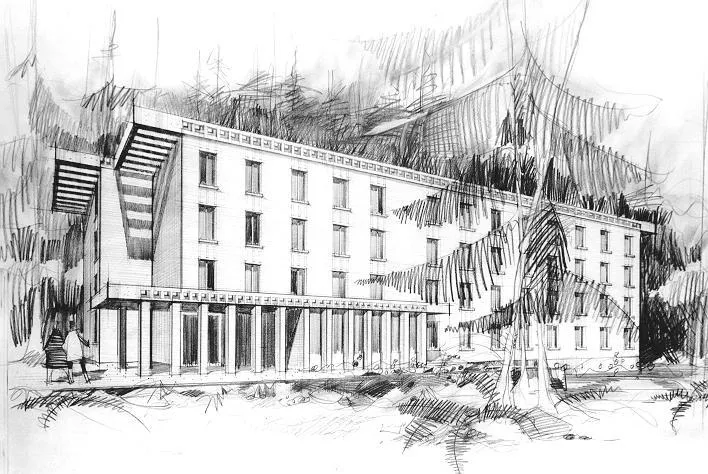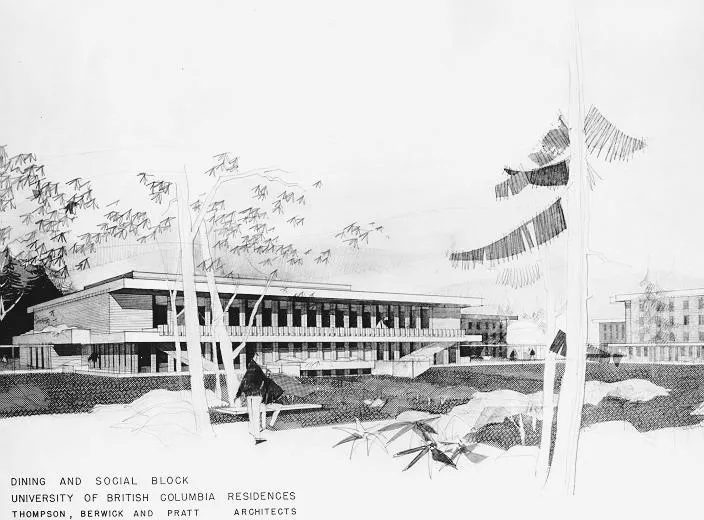Place Vanier was already a joke before I even lived there.
I can still see the look on my manager’s face as I told her where I had been assigned to live for my first year at UBC. As soon as I said Vanier, a look of pity washed over her.
My manager, a UBC student, knew the residence as old and decrepit, a place no one would actively choose to live in.
Even as I moved in and braved the endlessly awkward icebreakers of Jump Start, my living situation — a Vanier basement suite — remained a joke. I constantly mentioned the bars over my window, the complete lack of sunlight or the weird brown stains that dotted my walls. I would laugh along with everyone, but on the inside, I wondered — Was this room really the place I was going to spend my first year?
Oh well. I guess someone’s got to get the short end of the stick.
Until 1944, there was no student housing at UBC. But as the student body boomed after the Second World War, it became clear that UBC needed to start providing housing options for students — and fast.
With that, Fort Camp and Acadia Camp were born. Or, more accurately, bought.
The “Camp” in Fort and Acadia Camp was not arbitrary — these sites were buildings owned by the Department of National Defence. Some were bought by UBC for $1 (roughly $18 today) and others were turned over to or rented by the university by the Department of National Defence.
In the 1960s, The Ubyssey described the residences as “squalid.”
Once in 1964, the heating broke in a Fort Camp men’s residence for four winter weeks. So the men inhabited a nearby women’s residence “and threatened to stay there” until their heating was fixed. After being kicked out, the men protested on campus, carrying signs that said, “We Are Not Polar Bears.”
These residence buildings temporarily solved the increasing demand for UBC student housing — but they were nothing more than a band-aid on the wound of the university’s growing population. Enrolment increased 45 per cent from the 1944/45 to the 1945/46 academic year, the first school year after the end of the Second World War.
The poor quality of the residences also hindered student safety.
A 1954 Ubyssey article titled Fort Camp Huts Disgrace to UBC quoted then-Fire Chief R.S. McPherson saying “Fort Camp would burn to the ground in ten minutes if a fire went unchecked.”
As if living in constant fear of burning to death in a fire wasn’t enough, a 1961 student handbook painted a clear picture of the residence’s dilapidated state.
“A pioneering spirit is needed,” read the handbook. “No where else can you have your own private shower, rain through a hole in the roof.”
Eventually, Fort and Acadia Camp were set to be demolished. Tucked away on the fourth page of the January 14, 1969 edition of The Ubyssey, a short 250-word piece announced their demise: Acadia Camp has died—soon to be buried.
Now, Fort Camp’s remains are where the Museum of Anthropology is, a calm spot overlooking the Pacific Ocean. The site of Acadia Camp is now home to Acadia Park family housing.
In the late 1950s, it was clear that UBC’s decision to cheap out on residence costs during the war was coming back to bite them in a big way. The university needed a better, more permanent solution.
And, by October 30, 1959, it found one, with the opening of UBC’s first-ever permanent housing complex: Place Vanier.
In December 2023, UBC passed Campus Vision 2050.
Campus Vision 2050 details how UBC Vancouver’s physical campus will change and grow over the next 30 years. The plan includes commitments to establish a SkyTrain extension and revitalize UBC’s green spaces, but student advocates — like AMS executives — argue the most important goal is the expansion of student housing.
“UBC Vancouver is located in one of the world’s least affordable regions,” reads the Campus Vision 2050 plan. “The rising cost of living in Metro Vancouver, and of housing in particular, threatens UBC’s ability to recruit and retain faculty and staff and is making a UBC education less accessible.”
The plan commits to building 3,300 more student housing beds in addition to 1,000 beds to replace aging facilities. This will bring the total number of student beds on campus to 17,300.
One part of that planned expansion is an overhaul of Place Vanier.
Vanier’s reputation as a set of run-down buildings that I learned about as a naïve first year wasn’t unfounded — according to Campus Vision 2050, the residence building has “seismic deficiencies.” From the asbestos warnings that adorned my door to the gaping hole inside of my closet — I experienced the downsides of living in a 65-year-old building firsthand.
Second-year UBC student Sarah Dryden expressed similar concerns about the quality of Vanier’s accommodations.
“I think Vanier’s buildings are outdated,” said Dryden. “The bathrooms tend to get moldy … There’s sometimes silverfish and other bugs that sneak into the rooms.”
According to Campus Vision 2050, the Place Vanier expansion will increase student housing capacity and “create a more active and vibrant pedestrian environment through building design and ground-floor programming.” All of the Place Vanier buildings except the newer Tec de Monterrey and Korea-UBC houses will be demolished and replaced with newer residences.
Andrew Parr, the associate vice-president of student housing and community services at UBC, outlined the weight of UBC’s housing problem.
“Our waitlists are massive,” said Parr in an interview with The Ubyssey. “There’s literally thousands of students who would like to live on campus who we cannot accommodate because we don't have space.”
Parr also said the Place Vanier expansion could reinvigorate the campus community.
“The more students that live on campus, the more vibrant the community can be … the more other amenities that can be available for the entire community, [like] faculty, staff and commuter students to appreciate and enjoy as well,” said Parr.
Parr noted the redevelopment of Vanier won’t lead to temporary dips in student housing capacity.
“We wouldn't demolish everything at once,” he said. “We demo certain components, build back … and then move to the next phase, have students live there, move to the next phase and never be a net loss of beds throughout this process.”
According to Parr, it may not even be that long before buildings start falling. He said the Place Vanier expansion could begin as soon as 2028.
After replacing Fort and Acadia Camp, Vanier is now dying alongside them — for good reason. Its earthquake risk and low-density sprawl don't fit in a modern UBC.
Still, there is a tinge of sadness in knowing that Vanier’s days are numbered.
While the plans to demolish Vanier were announced in December 2023, it seems to not be common knowledge. The students I interviewed for this article didn’t know about the demolition.
Even as I learned of it, it felt like a footnote. I found out about the demolition in the middle of a 20-slide Instagram story about Campus Vision 2050. It wasn’t a headline — I would have missed it if I had zoned out and mindlessly clicked through one more story.
To me, it seems that Place Vanier is already being erased and that history is repeating itself.
In Acadia Camp has died—soon to be buried, the author said the residence was known for its “spirit.”
“The theory was that you had to have some kind of spirit to put up with the inferior living conditions.”
That spirit is what is often forgotten when we talk about these buildings.
Place Vanier may be brick, concrete and drywall, but it’s also so much more. Thousands and thousands of students have passed through its walls. And while Vanier’s reputation poorly precedes itself, the ability to laugh and joke about this shared experience with others is priceless.
Even if students don’t yet know of Vanier’s fate, it is not a place that will quickly fade out of view. It will be missed by many, including myself and second-year student Ava Webb.
For Webb, hearing about the destruction of a place they once called home was heartbreaking.
“It makes me sick, honestly. It was my home and leaving was so hard,” said Webb.
“Place Vanier was my last choice when I was ranking residences — it’s quaint and isn’t known for much — but leaving was one of the hardest things I’ve had to do,” said Webb. “I miss it every day.”
While I may have greeted the doors to Place Vanier with trepidation, I left them wishing I could have just one more day. My first year was disorienting, stressful, exhilarating and thrilling. Vanier was there for all of it.
Tucked away on the fourth page of the January 14, 1969 edition of The Ubyssey, a short 250-word piece announced their demise: Acadia Camp has died—soon to be buried.
Vanier may have been a joke, but it was our joke.
The houses will eventually fall, 65 years of history into the dirt. But even as the last brick hits the ground, these buildings will live on in the people who once called them home — in the memories of countless first days nervously walking up to the Commonsblock, ready to live away from home for the first time. It’ll stay alive in countless late nights spent with friends who would become lifelong connections.
The residence demolition can make Place Vanier seem dead. But as long as there are people alive who experienced it — like you and I — stories can still be told about those old, asbestos-filled beloved buildings.
Place Vanier will never be truly buried.
Share this article
First online




